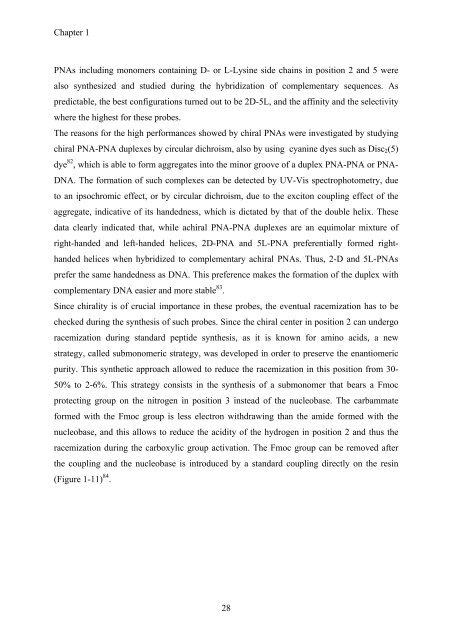View - DSpace UniPR
View - DSpace UniPR
View - DSpace UniPR
Create successful ePaper yourself
Turn your PDF publications into a flip-book with our unique Google optimized e-Paper software.
Chapter 1<br />
PNAs including monomers containing D- or L-Lysine side chains in position 2 and 5 were<br />
also synthesized and studied during the hybridization of complementary sequences. As<br />
predictable, the best configurations turned out to be 2D-5L, and the affinity and the selectivity<br />
where the highest for these probes.<br />
The reasons for the high performances showed by chiral PNAs were investigated by studying<br />
chiral PNA-PNA duplexes by circular dichroism, also by using cyanine dyes such as Disc 2 (5)<br />
dye 82 , which is able to form aggregates into the minor groove of a duplex PNA-PNA or PNA-<br />
DNA. The formation of such complexes can be detected by UV-Vis spectrophotometry, due<br />
to an ipsochromic effect, or by circular dichroism, due to the exciton coupling effect of the<br />
aggregate, indicative of its handedness, which is dictated by that of the double helix. These<br />
data clearly indicated that, while achiral PNA-PNA duplexes are an equimolar mixture of<br />
right-handed and left-handed helices, 2D-PNA and 5L-PNA preferentially formed righthanded<br />
helices when hybridized to complementary achiral PNAs. Thus, 2-D and 5L-PNAs<br />
prefer the same handedness as DNA. This preference makes the formation of the duplex with<br />
complementary DNA easier and more stable 83 .<br />
Since chirality is of crucial importance in these probes, the eventual racemization has to be<br />
checked during the synthesis of such probes. Since the chiral center in position 2 can undergo<br />
racemization during standard peptide synthesis, as it is known for amino acids, a new<br />
strategy, called submonomeric strategy, was developed in order to preserve the enantiomeric<br />
purity. This synthetic approach allowed to reduce the racemization in this position from 30-<br />
50% to 2-6%. This strategy consists in the synthesis of a submonomer that bears a Fmoc<br />
protecting group on the nitrogen in position 3 instead of the nucleobase. The carbammate<br />
formed with the Fmoc group is less electron withdrawing than the amide formed with the<br />
nucleobase, and this allows to reduce the acidity of the hydrogen in position 2 and thus the<br />
racemization during the carboxylic group activation. The Fmoc group can be removed after<br />
the coupling and the nucleobase is introduced by a standard coupling directly on the resin<br />
(Figure 1-11) 84 .<br />
28
















